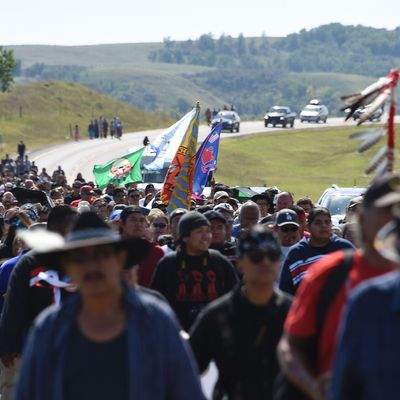
If it’s possible in this oversaturated age for a mass-protest movement to fly under the radar, the battle over the building of the $3.8 billion Dakota Access pipeline certainly qualifies. Just this past weekend in Morton County, North Dakota, 127 people were arrested during protests over renewed construction, which follows what protesters believed was relief from the federal government, in the form of a multi-agency letter to the pipeline builders, Energy Transfer Partners, asking them to halt building for tribal consultation and the preparation of environmental-impact statements. The construction has continued apace.
And yet the clash hasn’t quite risen to the level of front-page news. That’s despite the efforts of investigative journalist Amy Goodman, the host of the Democracy Now! independent news broadcast, who had an arrest warrant issued for her in September after her coverage of the situation. (A judge dismissed the charges.) “Not enough people realize what’s going on out there,” says Goodman. “It’s a bigger story than the amount of attention its received.”
So, what’s going on? The protesters, 270 or so who have been arrested since the standoff began in August, are a coalition of native people supporting the local Standing Rock Sioux, and they claim that the pipeline, which will carry sweet crude oil fracked from North Dakota’s Bakken oil patch through South Dakota and Iowa into Illinois, will endanger the region’s water supply, and that its construction is destroying their sacred lands. If you’ve got even the barest knowledge of the 150-odd-year history of native protests against the desecration and development of their land, you could be forgiven for assuming that things are unlikely to unfold in their favor. But in sheer scale, this resistance is bigger and more organized than any protests native people have undertaken in decades — thousands of supporters from more than 200 tribes have set up camp in Cannon Ball, North Dakota. Their protests have been frequently met with security forces armed with attack dogs and mace.
Goodman spoke to us from her home in New York shortly after returning from the latest of multiple visits to the front lines of the North Dakotan conflict.
What happened over the weekend that caused this latest escalation?
Because the pipeline company is accelerating its efforts to drill to the Missouri River. Remember, there was a letter sent by the Obama administration to the company — an unprecedented letter from the Department of Justice, Department of the Interior, and the Army — asking the company to voluntarily stop excavating. That clearly didn’t happen. Now, it’s not clear exactly what is happening, but it looks like the pipeline company is now trying harder to build. I suspect it’s to meet a deadline — that they have to build this pipeline or will default on an enormous amount of money and loans.
Why have these protests galvanized the native community? This isn’t the first time their land has been threatened in this way. What’s different now?
You’ve got members of tribes from all over the United States, Latin America, and Canada in North Dakota now. This is an epic struggle. It’s a struggle around climate change, renewable energy, native rights, and global warming. It’s about water. The protectors — and that’s what they’re calling themselves, not protesters — have a mantra: Water is life. The pipeline endangers the water for 10 million people. So it’s a multifaceted issue. And then the images have been so powerful. On Labor Day weekend, when people saw bulldozers carving up their sacred sites, hundreds of people came streaming in to resist, and the bulldozers kept going. Then the security guards unleashed their dogs on these Native Americans, biting them and their horses. We posted video of a dog dripping with blood from its mouth and nose. This is horrific stuff — it looks like Alabama in 1963.

It doesn’t quite seem to me as if these protests have really penetrated the public consciousness. Why do you think that is? Is the election eating up everyone’s attention?
I dare say the lack of coverage may be because this is a largely Native American resistance and protest. This is an under-covered population generally. Which is why it’s so critical that people do cover this, because when the situation is presented to people, they care. It’s not that people can only pay attention to one news story or a couple news stories at a time. The video I mentioned before — we released it on Democracy Now! Fourteen million people have watched that video. That is proof of public interest. And it’s not lost on the North Dakota authorities either. Take my arrest: I was charged with criminal trespass five days after that video went out. That was an arrest warrant on journalism. And those charges were dropped because a judge refused to authorize them. I’m not the only journalist who’s been arrested there. People are being targeted.
Like who?
Look, the chairman of the Standing Rock Sioux tribe, Dave Archambault, he’s arrested and strip-searched. The pediatrician on the local reservation, Dr. Sarah Jumping Eagle, she is brought to jail on a low-level disorderly conduct charge and then strip-searched. Shailene Woodley, the actress, who was here in support, she was asked by the authorities, “Are you Shailene Woodley?” When she said she was, she was taken to jail and strip-searched. This is humiliation and intimidation, and it’s to send a message: Do not come to North Dakota.
Do you have a sense of what the endgame is here? What’s the reason to be optimistic that the pipeline won’t ultimately get built?
Native people have had treaties broken for 150 years, so they didn’t have high hopes for the courts in this instance, but the Obama administration did weigh in with the three-agency letter. The Keystone XL pipeline, despite enormous Establishment support from both Democrats and Republicans, was ultimately rejected by President Obama. So there is reason for hope. But there are also very powerful companies involved. Whether they get to build this really depends on the power of the movement. Which, again, goes to why it’s so important that the media covers this. You mentioned the election before — this all goes directly to the candidates.
How so?
Donald Trump himself is directly invested in Energy Transfer Partners, the company that owns the pipeline and which will profit enormously if it’s built. And Hillary Clinton has over time been a very strong supporter of fracking — this is fracked oil. Has anyone asked them about it or about climate change? No. There was no question about climate change in any of the debates.
What does the non-native local population think of the pipeline?
Interestingly, the people of Bismarck and Mandan, North Dakota, decided not to allow the pipeline to cross north of them. They didn’t want the pipeline there. So it was moved to above the Native American reservation. The Native Americans are no different: No one wants this on their land.
What happens next?
It’s not clear what will happen or what the Obama administration will do, or if they will weigh in. Until that happens, we need to pay extremely close [attention] to whether or not the violence against the protesters increases. The police involved in the situation are militarized. They’re out there in MRAPs. The people are afraid that the police are meeting them with a degree of force that could lead to something very terrible. Remember when the Chelsea bombing happened and we all got emergency text alerts? That’s happening in North Dakota now. People are getting texts telling them that there are protesters in the area — it’s an attempt to criminalize and vilify these people, and turn the local non-native population against them. So the best I can say here is that, moving forward, there needs to be continued public pressure against the pipeline. The media needs to do much, much better with that.





























